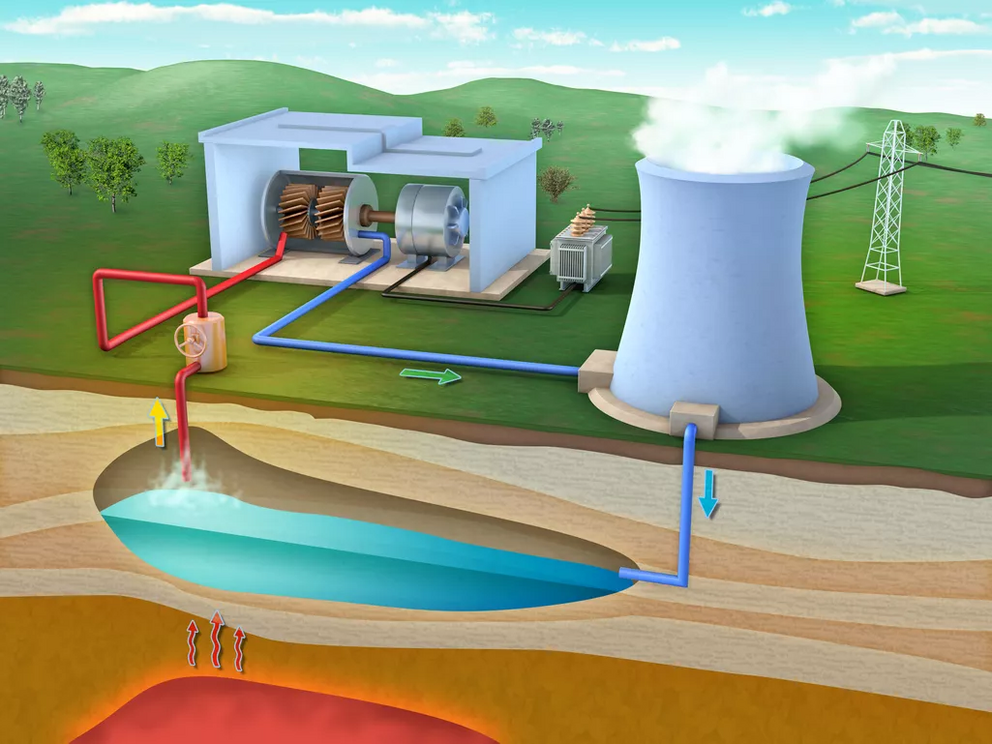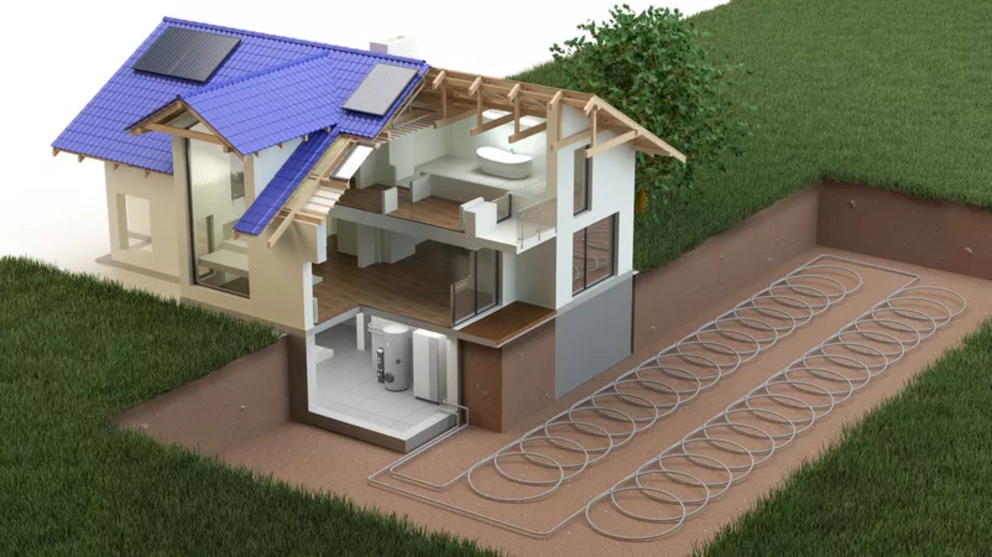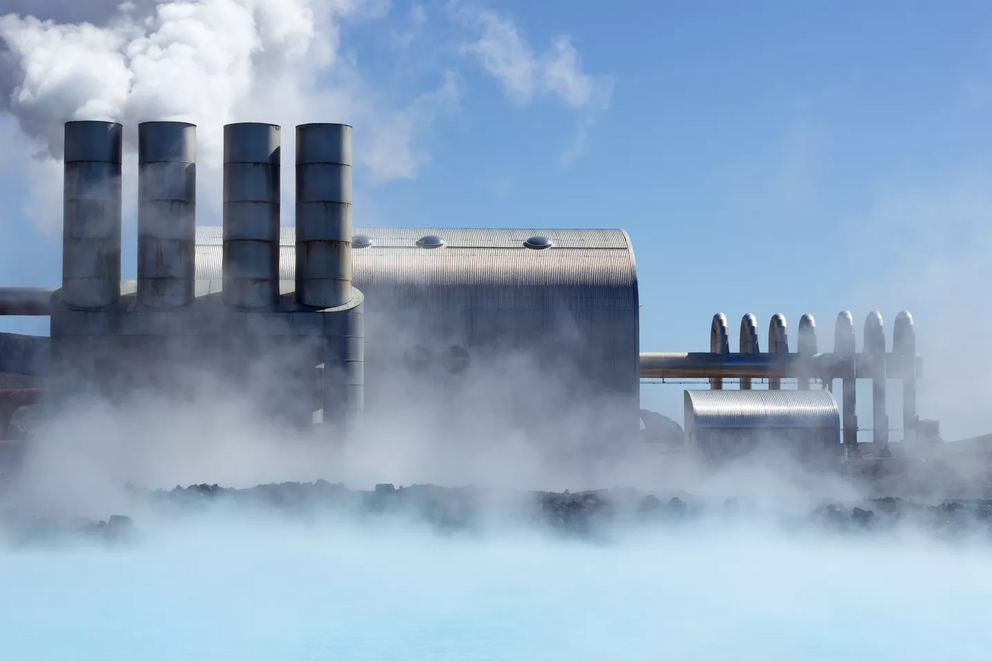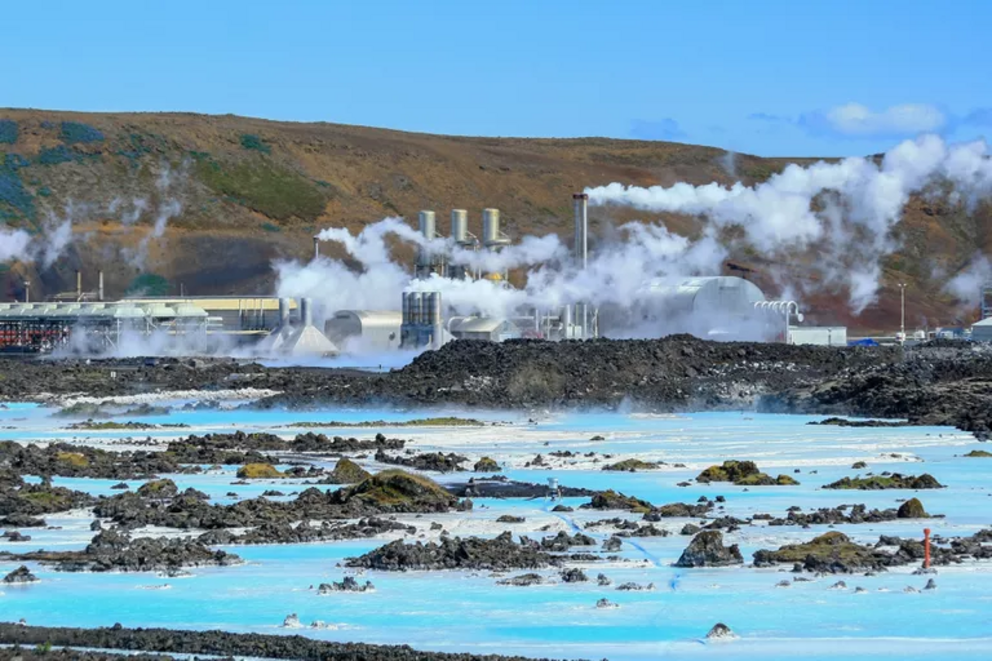What is geothermal energy? Definition, examples, and production process
Geothermal power plant at the Blue Lagoon in Iceland.
Geothermal energy is power produced through the conversion of geothermal steam or water to electricity that can be used by consumers. Because this source of electricity doesn’t rely on nonrenewable resources like coal or petroleum, it can continue to provide a more sustainable source of energy into the future. While there are some negative impacts, the process of harnessing geothermal energy results in less environmental degradation than other traditional power sources.
Geothermal Energy Definition
Coming from the heat of the Earth’s core, geothermal energy can be used to generate electricity in geothermal power plants or to heat homes and provide hot water via geothermal heating. This heat can come from hot water that is converted into steam via a flash tank — or in rarer cases, directly from geothermal steam. Regardless of its source, it’s estimated that heat located within the first 33,000 feet, or 6.25 miles, of the Earth’s surface contains 50,000 times more energy than the world’s oil and natural gas supplies, according to the Union of Concerned Scientists.1
To produce electricity from geothermal energy, an area must have three major characteristics: enough fluid, sufficient heat from the Earth’s core, and permeability that enables the fluid to interface with heated rock. Temperatures should be at least 200 degrees Fahrenheit to produce electricity, but need only exceed 45 or 50 degrees for use in geothermal heating.2 Fluid can be naturally occurring or pumped into a reservoir, and permeability can be created through stimulation — both through technology known as enhanced geothermal systems (EGS).
Naturally occurring geothermal reservoirs are areas of the Earth’s crust from which energy can be harnessed and used to produce electricity. These reservoirs occur at various depths throughout the Earth’s crust, can be either vapor- or liquid-dominated, and are formed where magma travels close enough to the surface to heat groundwater located in fractures or porous rocks. Reservoirs that are within one or two miles of the Earth’s surface can then be accessed via drilling. To exploit them, engineers and geologists must first locate them, often by drilling test wells.
History
Geothermal heat has been used for more than 10,000 years, and is thought to have begun when Paleo-Indians in North America used hot springs for warmth, bathing, healing, and cooking. Use of these springs in the U.S. continued with European settlers, was commercialized to include resorts, and continued as a cheap way to provide a source of warmth near homes.3
Then, in 1892, a geothermal district heating system was constructed in Boise, Idaho, by piping water from hot springs to homes — the first of its kind in the world. This system was duplicated in 1900 in Klamath Falls, Oregon, and a few short years later, in 1904, Prince Piero Ginori Conti invented the first geothermal power plant, located in Larderello, Italy.3
The first geothermal wells were drilled in the U.S. in 1921, eventually leading to construction of a geothermal power plant in the same location, The Geysers, between 1951 and 1960.4 Since that time, the use of geothermal technology has expanded throughout the United States and the world, and innovation continues to drive geothermal energy as a feasible alternative to oil and coal.
Cost of Geothermal Energy
Geothermal energy plants require high initial costs, often about $2,500 per installed kilowatt (kW) in the United States. That said, once a geothermal energy plant is complete, operation and maintenance costs are between $0.01 and $0.03 per kilowatt hour (kWh)5 — relatively low compared to coal plants, which tend to cost between $0.02 and $0.04 per kWh.6 What’s more, geothermal plants can produce energy more than 90% of the time, so the cost of operation can be covered easily, especially if consumer power costs are high.
How Does Geothermal Energy Work

The process of capturing geothermal energy involves using geothermal power plants or geothermal heat pumps to extract high-pressure water from the underground. After reaching the surface, the pressure is lowered and the water converts to steam. The steam rotates turbines that are connected to a power generator, thereby creating electricity. Ultimately, cooled steam condenses into water that is pumped underground via injection wells.
Here’s how geothermal energy capture works in greater detail:
1. Heat From the Earth’s Crust Creates Steam
Geothermal energy comes from the steam and high-pressure hot water that exist in the Earth’s crust. To capture the hot water necessary to power geothermal power plants, wells extend as deep as two miles under Earth’s surface.7 Hot water is transported to the surface under high pressure, until the pressure is dropped above ground — converting the water into steam. Under more limited circumstances, steam comes directly out of the ground, rather than first being converted from water, as is the case at The Geysers in California.
In the case of geothermal heat pumps, which are more commonly used for home systems, water or refrigerant is moved through a loop of underground pipes. When the year-round underground temperature is higher than the ambient temperature — like in the winter — the ground heats the water before it is recirculated into the house. The heat is then transferred to the home and the process begins again.
2. Steam Rotates Turbine
Once the geothermal water is converted to steam above the Earth’s surface, the steam rotates a turbine. The turning of the turbine creates a mechanical energy that can ultimately be converted to useful electricity. The turbine of a geothermal power plant is connected to a geothermal generator so that when it rotates, energy is produced. Because geothermal steam typically includes high concentrations of corrosive chemicals like chloride, sulfate, hydrogen sulfide, and carbon dioxide, turbines must be made of materials that resist corrosion.8
3. Generator Produces Electricity
The rotors of a turbine are connected to the rotor shaft of a generator. When the steam turns the turbines, the rotor shaft rotates and the geothermal generator converts the kinetic — or mechanical — energy of the turbine into electrical energy that can be used by consumers.
4. Water Is Injected Back Into the Ground
When the steam used in hydrothermal energy production cools, it condenses back into water. Likewise, there may be leftover water that isn’t converted into steam during energy generation. To improve the efficiency and sustainability of geothermal energy production, excess water is treated and then pumped back into the underground reservoir via deep well injection.
Depending on the geology of the region, this may take high pressure or none at all, as in the case of The Geysers, where water simply falls down the injection well.9 Once there, the water is reheated and may be used again.
Geothermal Power Plants
Geothermal power plants are the aboveground and underground components by which geothermal energy is converted to useful energy — or electricity. There are three major types of geothermal plants:
Dry Steam
In a traditional dry steam geothermal power plant, steam travels directly from the underground production well to the aboveground turbine, which turns and generates power with the help of a generator. Water is then returned underground via an injection well. Notably, The Geysers in northern California, and Yellowstone National Park in Wyoming are the only two known sources of underground steam in the United States.10
The Geysers, located along the border of Sonoma and Lake County in California, was the first geothermal power plant in the U.S. and covers an area of about 45 square miles. The plant is one of just two dry steam plants in the world, and actually consists of 13 individual plants with a combined generating capacity of 725 megawatts of electricity.11
Flash Steam
Flash steam geothermal plants are the most common in operation, and involve extracting high-pressure hot water from underground and converting it to steam in a flash tank. The steam is then used to power generator turbines; cooled steam condenses and is injected via injection wells. Water must be over 360 degrees Fahrenheit for this type of plant to operate.10
Binary Cycle
The third type of geothermal power plant, binary cycle power plants, rely on heat exchangers that transfer the heat from underground water to another fluid, known as the working fluid, thereby turning the working fluid into steam. Working fluid is typically an organic compound like a hydrocarbon or a refrigerant that has a low boiling point. The steam from the heat exchanger fluid is then used to power the generator turbine, as in other geothermal plants. These plants can operate at a much lower temperature than required by flash steam plants — just 225 degrees to 360 degrees Fahrenheit.10
Enhanced Geothermal Systems (EGS)
Also referred to as engineered geothermal systems, enhanced geothermal systems make it possible to access energy resources beyond what’s available through traditional geothermal power generation. EGS extracts heat from the Earth by drilling into bedrock and creating a subsurface system of fractures that can be pumped full of water via injection wells.
With this technology in place, the geographic availability of geothermal energy can be extended beyond the western United States. In fact, EGS may help the U.S. increase geothermal energy generation to 40 times current levels. This means that EGS technology can provide around 10% of the current electric capacity in the U.S.
Ground Source Energy for Homes
Although not related to heat from the Earth's core, warmth from the ground can be used to heat and cool homes with the help of geothermal heat pumps (GHPs) — also known as ground-source heat pumps or geoexchanges.12 These units take advantage of the consistent underground temperature, which typically ranges between 45 degrees and 75 degrees Fahrenheit all year.13 To do so, GHPs utilize an underground loop system consisting of a heat exchanger, water solution, and ductwork leading into the building.

In the winter, when the ground temperature is higher than the ambient temperature, the ground heats the circulating water; the thermal energy of the heated water is then concentrated by a water-to-air heat pump and circulated through the home. Alternatively, when summer temperatures exceed the underground temperature, excess heat from the home is pumped into the ground or used to heat water — thereby cooling the home.
In comparison to traditional HVAC systems, GHPs can reduce home energy costs by as much as 65%. What’s more, the GHP indoor units typically last around 25 years and ground loops can work for more than 50 years.13 That said, the initial investment of installing a GHP can be high, with an average cost between $12,000 and $30,000, including installation costs.14 Even so, the energy savings from these units tend to pay off capital costs within 10 years.
Geothermal Energy Pros and Cons
Geothermal energy has huge potential for creating cleaner, more renewable energy than is available with more traditional sources of power like coal and petroleum. However, as with most forms of alternative energy, there are both pros and cons of geothermal energy that must be acknowledged.
Some advantages of geothermal energy include:
- Cleaner and more sustainable. Geothermal energy is not only cleaner, but more renewable than traditional sources of energy like coal. This means that electricity can be generated from geothermal reservoirs for longer and with a more limited impact on the environment.
- Small footprint. Harnessing geothermal energy requires only a small footprint of land, making it easier to find suitable locations for geothermal plants.
- Output is increasing. Continuing innovation in the industry will result in higher output over the next 25 years. In fact, production is likely to increase from 16 billion kWh in 2019 to just over 52 billion kWh in 2050.15
Disadvantages include:
- Initial investment is high. Geothermal power plants require a high initial investment of around $2,500 per installed kW, compared to about $1,600 per kW for wind turbines.16 That said, the initial cost of a new coal power plant may be as high as $3,500 per kW.17
- Can lead to increased seismic activity. Geothermal drilling has been linked to increased earthquake activity, especially when EGS is used to increase energy production.
- Results in air pollution. Due to the corrosive chemicals often found in geothermal water and steam, like hydrogen sulphide, the process of producing geothermal energy can cause air pollution.
The Icelandic Example
 Svartsengi geothermal power plant in Iceland.
Svartsengi geothermal power plant in Iceland.
A pioneer in the generation of geothermal and hydrothermal energy, Iceland’s first geothermal plants went online in 1970. Iceland’s success with geothermal energy is due in large part to the country’s high number of heat sources, including numerous hot springs and more than 200 volcanoes.18
Geothermal energy currently constitutes about 25% of Iceland’s total production of energy.19 In fact, alternative energy sources account for almost 100% of the nation’s electricity.18 Beyond dedicated geothermal plants, Iceland also relies on geothermal heating to help heat homes and domestic water, with geothermal heating servicing about 87% of buildings in the country.20
Some of Iceland’s largest geothermal power plants are:
- Hellisheiði Power Station. The Hellisheiði power plant generates both electricity and hot water for heating in Reykjavik, enabling the plant to use water resources more economically. Located in southwest Iceland, the flash steam plant is the largest combined heat and power plant in Iceland and one of the largest geothermal power plants in the world, with a capacity of 303 MWe (megawatt electrical) and 133 MWth (megawatt thermal) of hot water. The plant also features a reinjection system for non-condensable gases to help reduce hydrogen sulphide pollution.21
- Nesjavellir Geothermal Power Station. Located on the Mid-Atlantic Rift, the Nesjavellir Geothermal Power Station produces about 120 MW of electrical power and about 293 gallons of hot water (176 degrees to 185 degrees Fahrenheit) per second. Commissioned in 1998, the plant is the second largest in the country.22
- Svartsengi Power Station. With an installed capacity of 75 MW for electricity production and 190 MW for heat, the Svartsengi plant was the first plant in Iceland to combine electricity and heat production. Coming online in 1976, the plant has continued to grow, with expansions in 1999, 2007, and 2015.23
To ensure the economic sustainability of geothermal power, Iceland employs an approach called stepwise development. This involves evaluating the conditions of individual geothermal systems in order to minimize the long-term cost of producing energy. Once the first productive wells are drilled, the production of the reservoir is evaluated and future development steps are based on that revenue.24
From an environmental standpoint, Iceland has taken steps to reduce the impacts of geothermal energy development through use of environmental impact assessments that evaluate criteria like air quality, drinking water protection, and aquatic life protection when choosing plant locations.25 Air pollution concerns related to hydrogen-sulphide emissions have also risen considerably as a result of geothermal energy production. Plants have addressed this by installing gas capture systems and injecting acid gases underground.26
Iceland’s commitment to geothermal energy extends beyond its borders to Eastern Africa, where the country has partnered with the United Nations Environment Programme (UNEP) to expand access to geothermal energy. Sitting on top of the Great East African Rift System — and all of the associated tectonic activity — the area is particularly well-suited to geothermal energy. More specifically, the UN agency estimates that the region, which is often subject to serious energy shortages, could produce 20 gigawatts of electricity from geothermal reservoirs.18

